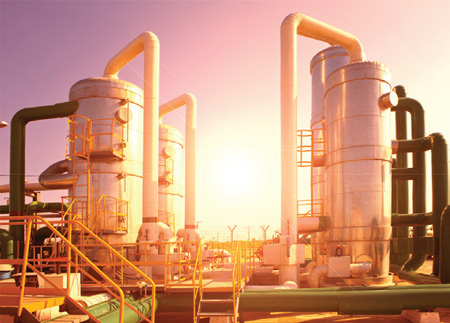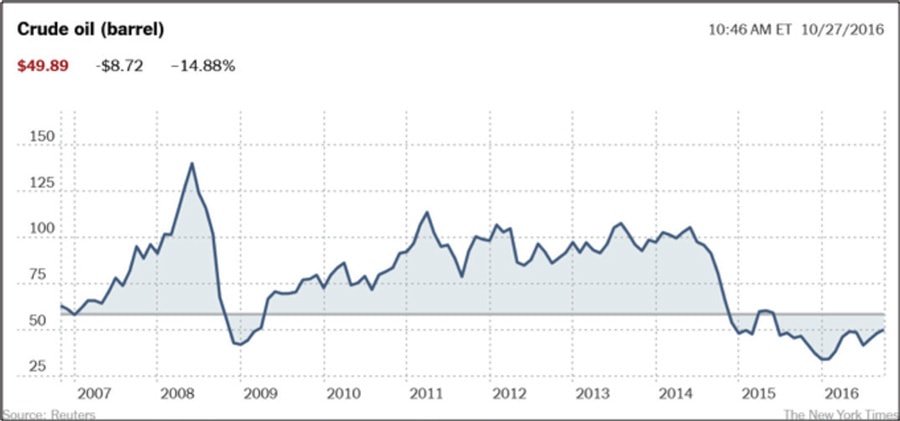Whitepaper
Increase Operational Efficiency with a Modern SCADA Infrastructure
New Ways to Reduce Costs, Get More Out of Infrastructure, and Maximize Profitability

Executive Summary

After going through a period of growth, the oil and natural gas industry in the United States is now experiencing one of the most transformative periods in its history. Oil and gas prices are down more than 60 percent since their June 2014 high. These new prices reflect factors such as increased production in the U.S., competitive responses from overseas producers, availability of new energy alternatives, and concerns about slowing economic growth.
In this environment, oil and gas companies must do all they can to reduce costs, rationalize their investments, and focus on various strategies to improve profitability. This includes continuing to minimize pipeline and equipment downtime. Yet merely cutting costs is not enough. In addition, these companies are being challenged to increase the efficiency of operations, especially upstream production, while facing tighter safety and environmental regulations.
It’s a tall order, but advanced technology solutions can help. One of the toughest issues oil and gas companies face is the need to maintain visibility into their most critical systems, and thereby overcome the potential blind spots that can lead to equipment or pipeline downtime. With the right technology to increase visibility, and systems that are always on, oil and gas companies can gain significant efficiencies and measurably improve their operations.
This in turn enables oil and gas companies to minimize costly downtime, maximize delivery, and achieve compliance with ever-expanding regulations. In short, they stand to gain results that pay off where it matters most: topline revenues and bottom-line profits. This white paper will describe how such a new pipeline experience can become a reality.
Industry Update
After a period of steady growth, the U.S. oil and natural gas industry is now in its deepest downturn since the 1990s. This decline is caused by a precipitous drop in prices; for example, the price of Brent Crude oil has fallen from a high of $112 a barrel in July 2014 to less than $50 today—a drop of nearly 60 percent. While prices have leveled off, they now appear to have stabilized in the range of $40-$50 a barrel, and many executives and industry analysts believe it will be years before oil returns to the glory days of $90-$100 a barrel.
Figure 1: The Volatility of Oil Prices and the 2014-2016 Decline

60 percent since June 2014. As a result, companies in this industry, as
well as the natural gas industry, need to do all they can to reduce costs
and improve profitability.
With the right technology to increase visibility, and systems that are always on, oil and gas companies can gain significant efficiencies and measurably improve their operations. In short, they stand to gain results that pay off where it matters most: topline revenues and bottom-line profits.
This means that oil and gas companies were suddenly blindsided by a significant drop in revenues, harsh news for those companies that had made record profits in recent years. As a result, they’ve had to decommission up to two-thirds of their rigs and sharply cut investment in exploration and production. Many companies have gone bankrupt and an estimated 250,000 oil workers—roughly half of whom are located in the United States—have lost their jobs.*
All of this adds up to an environment where oil and gas companies—both upstream and midstream—must do all they can to reduce costs and focus on those strategic initiatives that they can control in order to return to profitability. Yet at the same time, these companies must implement technology solutions that can do more than merely cut cost. These solutions must also contribute to increasing the efficiencies of existing operations and improving safety, compliance, and impacts on the environment and society.
* The New York Times, “Oil Prices: What’s Behind the Volatility? Simple Economics,” September 29, 2016.
Risks and Challenges Facing the Industry
Disruptions from oil and natural gas pipelines can have major impacts on public safety when something goes wrong. For example, consider the 2010 gas explosion that occurred in San Bruno, CA. Defective welds could not meet increased gas pressure that stemmed from growing energy demands, resulting in a severe explosion that produced a wall of fire more than 1,000 feet high. Thirty-five homes were destroyed, eight people died, the company’s stock price plunged, and ensuing lawsuits further damaged the provider’s reputation.
Or take the more recent example of a pipeline explosion that occurred in Shelby County, AL on October 31, 2016. In this case, the country’s largest gasoline pipeline—estimated to carry 40 to 50 percent of all the gasoline used on the East Coast— exploded after a subcontractor accidentally struck the pipeline with a backhoe. The accident killed one worker, injured four others, and resulted in the loss of nearly 400,000 gallons of gas. The entire company was shut down for six days and downstream gasoline distribution was significantly delayed.
There are many more examples of incidents like this all over the country, and unfortunately, more may occur. To keep everyone safe, regulators have imposed tougher legislation and regulations, stricter audits, and more severe fines for non-compliance. And it’s not just the regulators; community leaders are also pressuring oil and gas companies to increase safety and update outdated infrastructure that could lead to future accidents.
While these are examples of external pressures, oil and gas companies face their share of ongoing internal challenges, too. Examples of internal challenges include:
- Constant struggles to match supply and demand in real time
- A very real “talent gap,” which will have an adverse effect on operations, company growth, and profitability
- A scarcity of resources to address remote automation failures and performance issues in the face of increasingly complex systems
- Cuts in capital budgets for replacing or repairing equipment
- Increased pressure on outdated pipelines or compressor stations (due to increasing volumes)
- The continual accounting challenges faced by upstream producers related to the “imbalance sheet”
These challenges are represented by actual quotes from oil and natural gas companies:
“ We are experiencing unacceptable downtime with our ever increasingly complex IT systems.”
“ We have to send an army of people to remote locations to monitor critical parts of the pipeline manually if the systems are down.”
“ In some cases, we don’t have the technical IT skills, people, or resources to fix system issues at remote locations.”
“ We have to prove we are in compliance—and cannot be missing data; otherwise we can get fined.”
“ We are adding more and more complexity to our pipeline systems, making them more breakable.”
“ We have issues maintaining the accuracy of our gas imbalance sheet.”
All of these challenges exist in an environment where the overall importance and reliance on oil and natural gas has increased significantly in the last 10 years, despite the current product glut and resulting low price environment. Clearly, oil and gas companies need to carefully consider their options to find the right path to return to profitability.
Modernizing automation systems and updating aging SCADA assets is one area where the mandates of streamlining operations, increasing efficiency and meeting ever more stringent regulations yields rapid returns.
Conventional Approaches to SCADA Fall Short
Many oil and gas companies have tried to solve these problems with conventional IT servers running critical applications such as SCADA/HMI and Historian services in multiple locations.
Yet such an approach can present many challenges:
- The short useful life of conventional servers (averaging three to five years)
- The traditional implementation of separate servers for each critical application
- The need for multiple servers to achieve redundancy
- The space and power constraints in remote locations
- The persistence of unplanned downtime
- The time, manpower, and IT expertise required to perform maintenance, updates, or repairs
- The interruptions in data gathering that undermine the usefulness of data-analysis applications
- The inability to diagnose likely faults or failures, except after the fact
To overcome the limitations, inefficiencies and liabilities of these, often aging, conventional approaches, executives realize they need to modernize systems to overcome inherent challenges and keep equipment, operations, and pipelines up and running.
Virtualization, Always-On Operation, and Real-Time Analytics
Many forward-thinking oil and gas companies are now exploiting the combination of virtualization, always-on operation, and real-time data analysis to drive their business-critical systems. These three technologies have been widely adopted by enterprise businesses for quite some time, but are relatively new to oil and gas industry operations. Together, they have the potential to help reduce costs, optimize operations, and enable oil and gas companies to perform predictive maintenance (rather than scrambling to react to a fault or failure).
Virtualization delivers cost savings and efficiency
Virtualization enables companies to run more applications on one platform. Instead of a 1:1 server-to-application ratio, virtualization supports a one-to-many server-to-application ratio. By enabling one server to do the work of many servers, any organization can improve scalability and save money on infrastructure costs.
Yet while virtualization is a powerful tool for increasing efficiency, it carries some risks of its own. The more applications that are running on any one platform, the more important that platform becomes. If a virtualized server goes down, multiple applications can go down with it, leading to downtime and/or inability to see what’s happening in SCADA, Historian, or other critical applications. For this reason, it’s essential that the virtualized platform be protected from failure.
Fault-tolerant systems eliminate unplanned downtime
Oil and gas companies need fault-tolerant solutions that ensure close to 100-percent availability of their essential applications, in order to avoid interruptions, the cost of downtime, and risks to their corporate reputations.
Many IT and OT solutions marketed to the oil and gas industry claim high availability, but “close enough” is likely not “good enough.” The difference between “three nines” (99.9 percent) and “five nines” (99.999 percent) of availability is huge, and so too is the cost of paying for unplanned downtime.
An important by-product of using a truly fault-tolerant system is, of course, that the flow of real-time data from all business-critical applications to the control room (or data center) is also uninterrupted.
Real-time data analysis makes predictive maintenance a reality
In the short, medium, and long term, the ability of oil and gas companies to capture and analyze a steady stream of real-time data from their operations is becoming steadily more essential to their success.
Today, accurate real-time data enables some oil and gas companies to save hundreds of thousands of dollars each month, in imbalance-sheet reporting. Others—leveraging the improved visibility that systems with 100-percent availability and no lost data can provide—are able to perform predictive maintenance, identifying likely points of failure ahead of time and taking remedial action. Still others are connecting the data that their applications generate to Big Data analytics, gaining new insight into every aspect of their operations and preparing for the Industrial Internet of Things (IIoT).
The fastest path to cutting costs and improving efficiency is to eliminate failures, and proactively prevent equipment and pipeline downtime (and related losses). Advanced technology solutions from Stratus Technologies—solutions capable of improving scalability, uptime, predictive maintenance, and more—are a proven way for oil and gas companies to achieve these results.
A Single Solution That’s Simple to Operate
Today, the oil and gas industry is going through drastic changes, as a result of a drop in prices that appears to be the new norm for the foreseeable future. These new conditions have created a corresponding shift in priorities, where oil and gas companies can no longer afford to concentrate primarily on expansion and growth initiatives, but instead must reduce costs, improve the efficiency of operations, and protect existing infrastructure. In short, they must do all they can to get the most out of their current resources and attempt to maximize profitability.
The fastest path to cutting costs and improving efficiency is to eliminate failures, and proactively prevent equipment and pipeline downtime (and related losses). Advanced technology solutions from Stratus Technologies—solutions capable of improving scalability, uptime, predictive maintenance, and more—are a proven way for oil and gas companies to achieve these results.
Stratus has a 30-year track record of preventing downtime and ensuring maximum return on assets. Our flagship ftServer® integrates the key technologies of virtualization, fault tolerance (availability in excess of 99.999 percent), and real-time data capture in a single solution. Our customers—upstream, midstream, and downstream—are delighted with its operational simplicity, proactive support model, and ease of service. While we implement solutions that draw on advanced technology, we’re most concerned about addressing each customer’s specific needs.
If you’ve been thinking about modernizing your oil and/or gas automation systems, but aren’t quite sure where to begin, please contact us. For over 30 years Stratus Technologies has been helping companies keep their systems continuously operational, and we’d welcome the opportunity to see how we can help you.
To learn more, please visit www.stratus.com.






